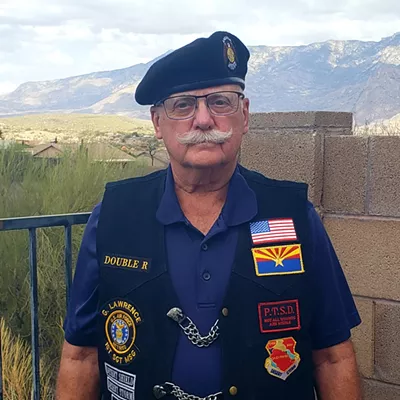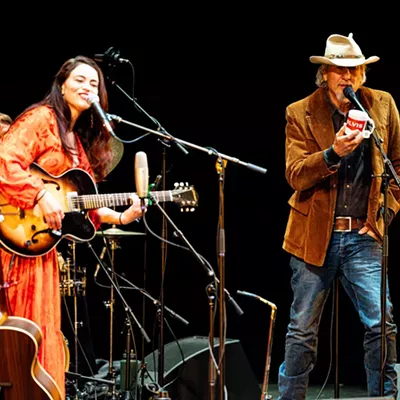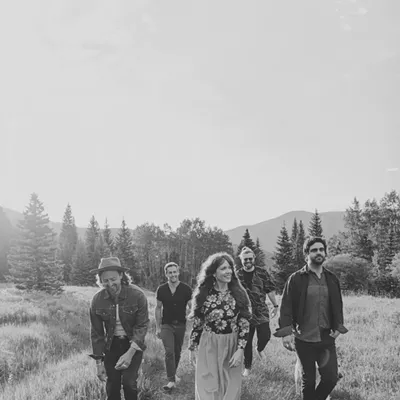This summer is a very special time for a very special sport you may not know about. But you should, since this city is a very special place for it.
That sport—and art, and lots of other things—is pole.
Yes, as in "pole dancing." But just like it's more than a sport, it's more than dance. And it's way more than what most people picture when they think of pole dancing.
In fact, pole is on its way to the Olympics, as a sport and an art form. And the U.S. group recognized by the International Pole Sport Federation—the international governing body that's getting pole to the Olympics—is headquartered right here in Tucson. That group, the American Pole League, is hosting its national championships this Saturday in the Old Pueblo.
So. Now you know.
But we still have tons to talk about—and to clear up regarding pole in general. Shall we?
A Note From the Writer
Penning this piece is kind of risky. Because pole carries stigma, and relatively few people understand it yet.
Actually, since pole is still surfacing in the mainstream, and because it's different things to different people, no single writer can explain it in a single article.
Still, I'm going to start to try explaining pole the way I understand and experience it. Because it's changed my life in an awesome way, and spreading the word might help it do that for others. And I'm a nice person who likes to help.
So do me a favor and be nice, too—lend me an open mind as you keep reading.
Pole Can Invert Patriarchy
First: what pole isn't.
Maybe when you hear "pole dancing" you first think (contemptuously) of strippers, and a bunch of anti-sex-work stigma. (Space constraints spare you from my diatribe here.)
Maybe the last thing you envision is empowerment.
But to me and millions of others, pole epitomizes empowerment. The pole—a simple piece of metal still often labeled a phallic symbol, a woman-objectification tool (no pun intended?)—is being reclaimed. When women wield this tool, we feel the power: the power to spin, to flip, to climb to a high ceiling, to muscle our own bodies upside-down like so many misogynistic aggressions built up inside us. It feels like we're not just upending patriarchy—we're releasing it along with endorphins, expelling it from our beings like toxins in sweat.
Maybe you have heard of "pole fitness"...and laughed at it as a ridiculous fad for lonely housewives trying to lose weight (for their husbands, right?) and be "sexy" (for their husbands, right?).
But pole fitness—which describes only a very specific type of pole, by the way—isn't about pleasing men. Actually, I can imagine that term going out of style, eclipsed by the more appropriate "pole sport," partly because it does evoke that lonely-housewife image and partly because for most polers, something like ripped abs is a funny-but-welcome byproduct, not pole's goal.
Conversely the phrase "pole dancing" poses problems for polers forced to explain their craft to a conservative grandma or boss, largely because that evokes the sad-stripper image.
Neither term covers the whole spectrum of what pole is and can be: fitness or dancing, fitness and dancing, or neither.
So I simply say "pole."
Then, Really, What Is It?
Modern pole can be sport, dance (from balletic to exotic), art, fitness or all that at once. It can be done in bare feet, platforms, pointe shoes, Reeboks or roller skates.
Its origins and influences range from age-old Chinese pole to contemporary gymnastics. In the ancient Indian practice mallakhamb, many moves traditionally performed by men on wooden poles mirror those now whipped out by women—and increasingly more men, nonbinary folks and (shocker!) kids—in modern pole studios on brass or chrome.
And many studio-taught tricks were pioneered by dancers in clubs, whom we're finally, thankfully, starting to give credit where it's due. (Some exotic dancers don't perform pole tricks; others do. No room here to expound.)
Finally, pole has broken free of its stigma enough that soon—again, as a sport and art (without the high heels) It may be in the Olympics alongside those parallel bars.
And pole has incredibly beneficial "side effects," like through-the-roof self-esteem, deep friendships and ... well, yeah ... "pole abs."
A few truisms I've discovered about my passion:
• Not everyone starts pole to get fit, but you won't excel if you're not.
• Not everyone starts pole to develop coordination and grace, but you won't excel if you don't.
• Not everyone starts pole to be powerful, but it's impossible to try it a few times and never feel that way.
• Not everyone starts pole to bond with others in a caring community, but every long-term poler will.
A Snippet of My Story
Pole captured my curiosity in late 2015. I came across a blog post about its deep link to feminism and uncanny ability to mend psychological issues (in the blogger's case, an eating disorder). Inspired, I dragged a friend to an intro class. It was hard, but I was hooked.
Now pole has captured my soul. Teaching it—at Kinetic Arts Tucson, a new studio in an old building in the heart of downtown—gives me a bird's-eye view of how pole empowers people of all backgrounds, body types, ages, aptitudes, attitudes and gender identities.
As I watch my students grow, I remember all my own pole "firsts:" first sit, first spin, first climb, first inversion...first mastery of moves with names like Cupid, Superman, jasmine, genie.
When, at the beginning of each class, I ask if students are dealing with any physical limitations, I remember when I first imagined pole as a physical activity I could love despite almost losing my leg in a bad accident. In 2008 I was on a bicycle when a semi-truck ran over my left leg, pulverizing the tibia, leaving me bed-bound for a year. After my second bone graft I could walk, but I'd never run again. Now, although my bad leg still hinders me even in pole, I often totally forget about it while flying around up there.
When a female student seems nervous folding up her tank top to expose belly skin for a better grip on the pole, I remember how vulnerable I felt when I first took off my tank in class, standing there in a sports bra and shorts surrounded by mirrors and...other people. Until those people—my teacher and fellow students—made me more comfortable, and then I got on the pole and forget to be shy. With every class I'd feel less self-conscious until that time I forgot to put my shirt back on before walking outside. And like that blogger who first piqued my interest in pole, I've found it's helped me heal from my own eating disorder.
How does pole foster body acceptance? For one thing, it makes you value your body's capabilities over its looks. For another, pole's mental and psychological aspects—like the willpower it takes to get strong and flexible enough for harder moves—makes you better at loving your whole self.
And when a student's strength and skill enthrall me—especially when they started with little of either, as I did (because, people, you don't need strength to start pole; pole gives you strength)—I marvel at how it also promotes accepting others, building an incredibly cohesive, supportive pole community worldwide.
I'm not saying a pole studio is some magic place where judgment and jealousy don't exist...but they don't happen there much, relatively. One common pole commandment—along with "Point your effing toes!"—is to only compare yourself to the athlete you were yesterday.
So Forget Competition...Except for This One
So now pole is pushing toward the Olympics.
And since the U.S. nonprofit spearheading the push—the American Pole League—is based in Tucson, we're hosting its national championships, whose top competitors can advance to the IPSF's worlds in Montreal this year.
There are many pole competitions out there, but this one stands apart because, geared toward gaining pole Olympic-sport status, its rules are particularly exacting. There are compulsory moves, artistic and choreography points, technical bonuses and deductions. Routines in the Pole Sport category need a specific number of "elements" with specific point values. Artistic Pole participants face fewer complexities but must also be at the top of their game, conveying a story merely through music, movement and costume.
Something else you didn't know: Two top names in pole sport globally live here. Sixty-one-year-old Renee Peyton took third in the IPSF's championships in Spain last year. Paige Olson, just 14 (she started pole at 9), holds too many top-level titles to list. Their strength, flexibility and grace are mesmerizing.
So now, you're a bit wiser about this amazing emerging sport that's going big-time right under your nose.
And some summer in the not-too-distant future, you might flip on your TV to the Olympic Games and see a fellow Tucsonan on your screen flying up, down and around a vertical metal pole. ■
The APL's national championships happen Saturday, July 27, at Sporting Chance Center, 2100 E. Curtis Road. Get tickets and more info at americanpoleleague.org/championship. Visit kineticartstucson.com to try pole yourself—beginner or not. This writer would love to meet you.







